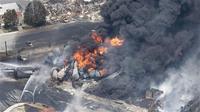-
Simulations reveal California’s resilience to extreme droughts
The results from a series of several-year-old computer simulations reveal that the state of California may be more resilient to long-term drought conditions than previously believed. “The results were surprising,” said one of the scientists involved in the study. “California has a remarkable ability to weather extreme and prolonged droughts from an economic perspective.”
-
-
U.S. should emulate allies in pushing for public-private cybersecurity collaboration
Israeli Prime Minister Benjamin Netanyahu announced last month the formation of a national cyber defense authority to defend civilian networks under the leadership of the Israel National Cyber Bureau.The “U.S. government has a lot to learn from successful examples in allied nations. With more compromise and reform, there is plenty of reason for hope,” says a cybersecurity expert, adding that “a cybersecurity partnership between government, business, and individuals built on trust is possible, and would promote more resilient networks as well as creative thinking on cybersecurity.”
-
-
Debate continues over releasing Pennsylvania crude oil shipment information
Shipment of crude oil by rail in the United States has increased from 800,000 barrels a day in 2012 to 1.4 million in 2014. In western Pennsylvania, over seventy-five million gallons of crude oil are passing through Allegheny and Westmoreland counties to refineries in Philadelphia. Release of the recently classified rail transport records by Pennsylvania Emergency Management Agency (PEMA) was a result of a federal mandate ordering railway companies to share information on interstate shipments of crude oil with state emergency management officials.Railway companies claim that releasing the information threatens security and is commercially sensitive.
-
-
Some states are better prepared than others for climate change challenges
In recent years, a number of states have started taking action to prepare their communities for climate change. Many have even developed specific adaptation plans to guide their work. Until now, though, no one has been able to define how much progress states are actually making in implementing those plans. The Georgetown Climate Center’s (GCC) online tool, the State Adaptation Progress Tracker, changes that. A GCC release says that now, anyone will be able to quickly determine how much progress their state is making and decision-makers will be able to learn from innovative examples of actions other states are taking.
-
-
The likelihood of a California Big One “uncomfortably high”: Experts

Research on the San Andreas fault has shown that the average time between surface-rupturing earthquakes is about a century. Experts say that these findings are a call to action. The last two “big ones” on the San Andreas fault — in 1906 in Northern California and 1857 in Southern California — occurred more than a century ago. There are several ways to calculate the probability of a similar earthquake, but they all give uncomfortably high results. A large earthquake is likely in our lifetime. A magnitude 7.8 earthquake is realistic, one expert says. “Our data show that similar earthquakes happened here in the not-too-distant past. As Shakespeare said, past is prologue. However, past large earthquakes on the San Andreas fault affected very few people. Now millions are at risk.”
-
-
Reliance on BP, feeble regulations make U.S. partially culpable in Deepwater Horizon oil spill
A recent ruling by a federal judge that BP was “grossly negligent” in the 2010 Deepwater Horizon oil rig spill in the Gulf of Mexico placed the majority of blame on the multinational oil and gas company. Although not on trial in this case, the federal government was also culpable in the largest oil spill in U.S. history, according to a new paper. Based on reports from the National Commission on the BP Deepwater Horizon Oil Spill and Offshore Drilling, the Chief Council’s Report and other government documents, the report’s authors determined that the government’s reliance on market-based accountability mechanisms and its failure to implement a regulatory process based on a mutually agreed upon set of robust standards and voluntary information disclosure led to the largest oil spill in U.S. history.
-
-
Federally funded cybersecurity center launched
The National Institute of Standards and Technology’s (NIST) National Cybersecurity Center of Excellence(NCCoE) initiative has awarded the first federally funded research and development center (FFRDC) contract for cybersecurity to MITRE Corp., a nonprofit established to operate FFRDCs. Cybersecurity professionals will work with stakeholders in government, the private sector, and academia to develop low cost and scalable cybersecurity solutions.
-
-
As sea level rises, coastal communities brace for more frequent, destructive tidal flooding
Today, many coastal communities are seeing more frequent flooding during high tides. As sea level rises higher over the next fifteen to thirty years, tidal flooding is expected to occur more often, cause more disruption, and even render some areas unusable — all within the time frame of a typical home mortgage. An analysis of fifty-two tide gauges in communities stretching from Portland, Maine to Freeport, Texas shows that most of these communities will experience a steep increase in the number and severity of tidal flooding events over the coming decades, with significant implications for property, infrastructure, and daily life in affected areas. The report warns that given the substantial and nearly ubiquitous rise in the frequency of floods at these fifty-two locations, many other communities along the East and Gulf Coasts will need to brace for similar changes.
-
-
Smart grid needed to shift electrical system to alternative energy: Expert
Solar, wind, and other alternative sources are easier on the environment but less predictable than coal, gas, or oil-fired plants, demanding a more sophisticated distribution and delivery system. A more resilient, responsive electrical grid – a smart grid – would adjust electrical loads to energy demands, preventing the shutdowns that leave people without air conditioning just when they need it most. A smart grid is thus a flexible grid – it is an infrastructure which allows shifting load and demand around effectively, ultimately balancing the electrical power and delivery system at lower costs.
-
-
Fusion reactor concept could be cheaper than coal
Fusion energy almost sounds too good to be true — zero greenhouse gas emissions, no long-lived radioactive waste, a nearly unlimited fuel supply. Perhaps the biggest roadblock to adopting fusion energy is that the economics have not penciled out. Fusion power designs aren’t cheap enough to outperform systems that use fossil fuels such as coal and natural gas. University of Washington engineers hope to change that. They have designed a concept for a fusion reactor that, when scaled up to the size of a large electrical power plant, would rival costs for a new coal-fired plant with similar electrical output.
-
-
California needs $54 million to deploy ShakeAlert earthquake warning system
Officials in California need $54 million fully to implement the ShakeAlert earthquake warning system, according to a scientist with the U.S. Geological Survey (USGS).ShakeAlert detects earthquakes using the California Integrated Seismic Network of roughly 400 ground motion sensors which identify primary waves (P-waves) as they move through the Earth at almost twice the speed of the earthquakes’ destructive S-waves, which shake the ground.When an earthquake is detected, ShakeAlert informs emergency management officials of the quake’s epicenter, and a computer-generated voice counts the remaining time before shaking occurs.
-
-
Scientist reveals Chelyabinsk meteorite fall’s seismo-ionospheric effects
The meteorite which hit the Russian city of Chelyabinsk on 15 February 2013 was the cause of a large number of dynamic ionospheric, atmospheric, and seismic phenomena. Its explosion created panic among local residents and about 1,500 people were injured seriously enough to seek medical treatment. All of the injuries were due to indirect effects rather than the meteor itself, mainly from broken glass from windows that were blown in when the shock wave arrived, minutes after the superbolide’s flash.
-
-
Boston developers continue to build on the waterfront, but take account of sea level rise
The threat of rising sea levels has not discouraged property developers and buyers in Boston from investing in multi-million dollar condos located along the city’s waterfront. Boston developers are keeping copies of key building records off-site in case electricity shuts down during a storm surge. Some developers are moving mechanical systems from the basements of high rises to several stories above ground, to ensure power and critical systems are intact during a flood.
-
-
U.S. Cyber Command plans to recruit 6,000 cyber professionals, as U.S. mulls offensive cyber strategy
Last Wednesday, House Intelligence Committee Chairman Mike Rogers (R- Michigan) told reporters that he would like to see the United States adopt a more offensive strategy in cyberspace, but added that the Pentagon, intelligence agencies, and law enforcement must first develop protocols for offensive cyber measures.The following day, U.S. Cyber Command (USCYBERCOM) announced plans to recruit 6,000 cyber professionals and create 133 teams across the country to support the Pentagon in defending the nation’s cyber infrastructure.
-
-
Petroleum industry, railroads want deadline extension for phasing out old tank cars

Transportation of crude oil by train jumped to 408,000 in 2013, from 11,000 in 2009, partly due to the rise in production from North Dakota’s Bakken region, where oil production has surpassed pipeline capacity. The increasing use of rail to transport crude oil has resulted in several accidents. The Department of Transportation want to phase out older tank cars — because they have thinner shells and are thus more vulnerable to accidents when transporting flammable liquids like crude oil – and replace them with new, safer tank cars with thicker shells. The petroleum industry and U.S. railroads want DOT to extend the deadline for phasing out old tankers from two years to four years.
-
More headlines
The long view
Water Wars: A Historic Agreement Between Mexico and US Is Ramping Up Border Tension
As climate change drives rising temperatures and changes in rainfall, Mexico and the US are in the middle of a conflict over water, putting an additional strain on their relationship. Partly due to constant droughts, Mexico has struggled to maintain its water deliveries for much of the last 25 years, deliveries to which it is obligated by a 1944 water-sharing agreement between the two countries.
Trump Is Fast-Tracking New Coal Mines — Even When They Don’t Make Economic Sense
In Appalachian Tennessee, mines shut down and couldn’t pay their debts. Now a new one is opening under the guise of an “energy emergency.”
Smaller Nuclear Reactors Spark Renewed Interest in a Once-Shunned Energy Source
In the past two years, half the states have taken action to promote nuclear power, from creating nuclear task forces to integrating nuclear into long-term energy plans.
Keeping the Lights on with Nuclear Waste: Radiochemistry Transforms Nuclear Waste into Strategic Materials
How UNLV radiochemistry is pioneering the future of energy in the Southwest by salvaging strategic materials from nuclear dumps –and making it safe.
Model Predicts Long-Term Effects of Nuclear Waste on Underground Disposal Systems
The simulations matched results from an underground lab experiment in Switzerland, suggesting modeling could be used to validate the safety of nuclear disposal sites.
